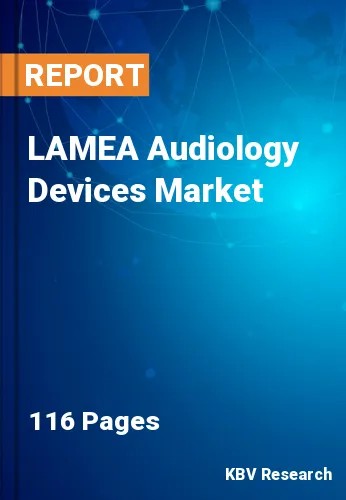The Latin America, Middle East and Africa Audiology Devices Market would witness market growth of 8.9% CAGR during the forecast period (2022-2028).
A behind-the-ear hearing aid with a thin tube, a receiver-in-the-canal hearing aid, or a receiver-in-the-ear cochlear with an open dome in the ear is all examples of open-fit hearing aids. This design maintains a fairly wide ear canal, allowing low-frequency sounds to naturally enter the ear and high-frequency sounds to be amplified by the hearing aid. Because of this, the design is suitable for those who have mild to moderate high-frequency hearing loss in addition to better low-frequency hearing.
Hearing aids come in a wide range of prices, sizes, features, and insertion techniques. There are several typical hearing aid designs across the market, starting with the tiniest and least noticeable in the ear. To satisfy consumer demand for a hearing aid that is barely visible, hearing aid manufacturers are creating smaller hearing aids. Adults with mild to severe hearing loss benefit from it.
The common understanding of hearing impairment is inadequate in many African countries, and the lack of resources has prevented the development of screening programs. In its 2021 World Report on Hearing, the WHO predicts that 136 million people in the WHO Region of Africa have some hearing impairment and that 39.9 million, or 3.6%, have a moderate or higher grade. Africa will have 332 million people with hearing loss by the year 2050. Due to variations in methodology and standards, studies on hearing loss conducted in various nations may not always allow for fair comparisons. The number of participants in each study, the research methods, and variances in generally recognized criteria of hearing loss can all affect results. The articles on these pages give a comprehensive picture of hearing loss prevalence in various nations. The majority of surveys focus on hearing loss in children.
The Brazil market dominated the LAMEA Audiology Devices Market by Country in 2021, and would continue to be a dominant market till 2028; thereby, achieving a market value of $319.4 million by 2028.The Argentina market is experiencing a CAGR of 9.5% during (2022 - 2028). Additionally, The UAE market would display a CAGR of 8.6% during (2022 - 2028).
Based on Technology, the market is segmented into Digital and Analog. Based on Product, the market is segmented into Hearing Aids, Cochlear Implants, Diagnostic Devices, and BAHA/BAHS. Based on Hearing Aids Type, the market is segmented into Behind-the-ear (BTE) and In-the-ear (ITE) & Others. Based on Distribution Channel, the market is segmented into Offline and Online. Based on End User, the market is segmented into Hospitals & Clinics, Ambulatory Surgical Centers and Others. Based on countries, the market is segmented into Brazil, Argentina, UAE, Saudi Arabia, South Africa, Nigeria, and Rest of LAMEA.
Free Valuable Insights: The Global Audiology Devices Market is Predict to reach $16 Billion by 2028, at a CAGR of 6.2%
The market research report covers the analysis of key stake holders of the market. Key companies profiled in the report include Siemens AG, Medtronic PLC, William Demant Holding A/S, GN Store Nord A/S, Sonova Holding AG, WS Audiology A/S, Natus Medical Incorporated, MED-EL GmbH, Starkey laboratories, Inc., and Benson Medical Instruments.
By Technology
By Product
By Distribution Channel
By End User
By Country
Our team of dedicated experts can provide you with attractive expansion opportunities for your business.

